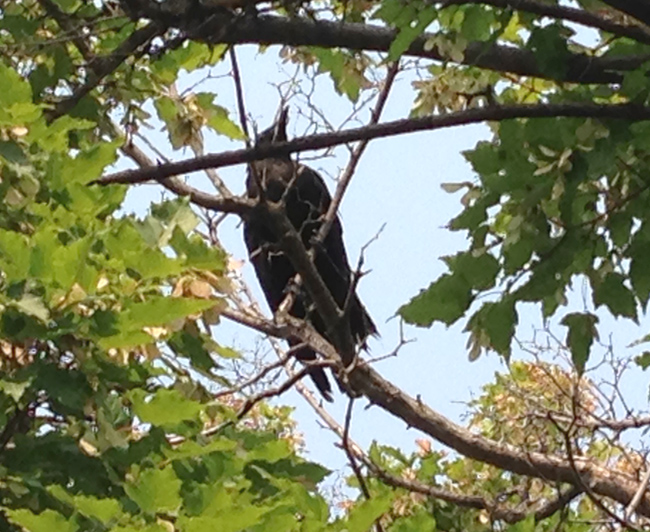
Kamloops woman monitoring injured bird
By Michele Young
For more than a month, Wendy Ross has kept an eye on an injured backyard visitor.
A young crow, its wing sprouting dishevelled feathers, has been hopping around the neighbourhood since early July.
Her yard is fenced, so at first she was concerned the obviously injured crow would be trapped, but it has been able to climb up a lilac bush and get out.
When he got out, she worried he would soon be dead from attacks by local cats, dogs or other creatures. Instead, the corvid has eluded people, pets and predators and has sought safety in the low-slung branches of a tree in Ross’s front yard.
She has put out water for the crow, and it seems to be finding enough food to survive.
“He's very shy and as soon as I go outside, if he's down from the tree, he hops quickly to get back to it,” she said.
“I guess I'm just wondering if there are any other options out there. I want him to survive. I'm surprised he's managed to stay safe with him only being able to hop everywhere he goes.”
Although winter seems like a long way off in the heat of the Kamloops summer, it has crossed Ross’s mind how the crippled crow will survive in the cold and snow. She has asked around to find out if there’s an agency that can take the injured bird, but she hasn’t had any luck.
Problem is, crows are classed by the B.C. Ministry of Environment as Schedule C creatures, said Tara Geiger, animal-care supervisor at the B.C. Wildlife Park.
Any animals on Schedule C are not endangered, they’re not threatened, in fact they’re quite abundant. Basically, they’re not animals that will be saved.
“We do get a lot of calls about this kind of thing,” Geiger said earlier this week.
“Crows are on a schedule C list. We’re not allowed to rehab them because they feed off native birds’ eggs and it’s believed they cause a decline in some of other birds’ populations, such as songbirds and ducks.”
Geiger said the wildlife park gets a lot of calls about injured or grounded birds, but tit doesn’t have the space for them or for several other wild creatures, including black bears, cougars, lynxes, grizzly bears and wolves.
The Ministry of Environment assesses the wildlife park’s intake, so it keeps tabs on who’s admitted for treatment there.
That said, Geiger did note that many crow calls involve fledglings who usually take to the wing within a few days.
If the bird is actually injured, it’s recommended that someone keep an eye on it and monitor the situation. If the crow seems to be suffering — it’s starving or getting attacked — the park can take it and humanely euthanize it, she said.
That said, crows are hardy birds and, being scavengers, they can often find ways to survive.
Geiger didn’t know if an injured crow would be able to make it through the winter. She said it would depend on factors such as food sources.
“We don’t recommend feeding them, because that attracts other wildlife. They are imprintable, they will depend on people for food rather than looking around themselves,” she said.
“We don’t usually recommend feeding them. But for the winter, it’s a balancing act.”
If you find injured wildlife in the Kamloops area, you can contact the B.C. Wildlife Park for advice before touching the animal at 250-573-3242 extension 230. The park can’t pick up animals, but if it can accept the creature, you might be asked to take it in in a box or create with a towel over the top to help keep it calm.
